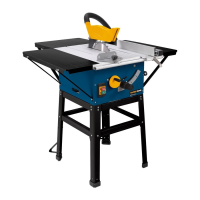6.4.3 Cutting width (Fig. 26 - 28)
• The parallel stop (7) has to be used when making longitudinal cuts in
wooden workpieces.
• The parallel stop (7) should be mounted on the right-hand side of the
saw blade (5).
• Place the parallel stop (7) on the guide rail for the parallel stop (12)
from above (Fig. 26).
• There are 2 scales (j/k) on the guide rail for the parallel stop (12)
which show the distance between the stop rail (e) and the saw blade
(5) (Fig. 27).
• Depending on this, choose the appropriate scale to suit whether the
stop rail (e) is turned for thick or thin material:
High stop rail (thick material): Scale j
Low stop rail (thin material): Scale k
• Set the parallel stop (7) for the required dimension using the inspec-
tion window (I) and secure it using the eccentric lever for the parallel
stop (28).
6.4.4 Adjusting the stop length (Fig. 29)
• The stop rail (e) can be moved in longitudinal direction in order to
prevent the workpiece from getting jammed.
• Rule of thumb: The rear end of the stop comes up against an imagi-
nary line that begins roughly at the center of the blade and runs at an
angle of 45° to the rear.
• Set the required cutting width.
• Slacken the wing nuts (f) and push the stop rail (e) forward until it
touches the imaginary 45° line.
• Tighten the wing nuts (f) again.
WZTS_1700_AUS_SPK7.indb 30 21.05.12 15:56

